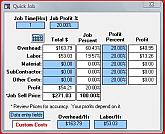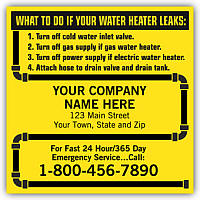For over a dozen years,
NSPG has been providing the tools that allow contractors to
increase profits and minimize business hassles. With our
simple-to-use-tools, you can make being a business owner
what you always wanted to it be -
successful, profitable and rewarding.
 Better Than Average? Better Than Average?
Most business owners work in almost complete isolation
from their colleagues. They have no idea how they
compare to their competitors in anything but price.
Sales, profits, benefits, etc. are all unknowns.
While it's now easy to track you own business
performance, how you measure up against other businesses
is a mystery.
There are many sources for this type of information, but
they often cost too much or are too complicated for a
normal business person to use. So, we thought we'd
take a look at a few industry statistics that may relate
to your business. All numbers relate to the United
States, and reflect information that is at least two
years old. (Do not use any
numbers here to run your own business. You must
find and use your own numbers).
There are over 5 million corporations in America.
They range from small Chapter S to multi-nationals.
There are about 55,000 Plumbing, heating, and AC
contractors with total sales of about $75 billion.
When you include the partnerships and sole proprietors,
total sales are almost $100 billion. Sales by all
electrical contractors are about $75 billion.
OK, those numbers are so big they really don't relate to
any individual business. For some businesses, it
explains why it seems like there's competition around
every corner.
So what do the numbers say about individual companies
and even employees?
Based on census questionnaires, there are over 800,000
people working in Plumbing and HVAC, and almost 650,000
in Electrical. The average sales per employee in a
Plumbing or HVAC business is about $112,000. In
Electrical, the average is about $101,000. So, an
average company with three techs, an office employee, and a manager,
your gross sales should be over $500,000.
Of course this assumes you're running an average
business. If you live in a high or low cost area, your
numbers could vary significantly. Also, being
average in these businesses is not necessarily a good
thing. The net profit numbers for Plumbing, HVAC,
and Electrical corporations are less than 5%.
 Being an average business will get you about the same
return as a one year CD. For all the work and risk
involved in running your business, a reasonable return
should probably be higher than what you can get in a CD. Being an average business will get you about the same
return as a one year CD. For all the work and risk
involved in running your business, a reasonable return
should probably be higher than what you can get in a CD.
You might think these profitability numbers are not much
higher than many large corporations. So what's the
problem? In general, large corporations with low
profit margins increase their value by getting larger
every year. Traditionally low margin businesses
maintain their investors by adding locations, increasing
their service areas, and generally adding to the "value"
of the corporation in ways that are not directly seen as
profit.
So, the average Plumbing, HVAC, or Electrical business
can maintain itself with these low annual profits only
if the value of the company continues to increase.
This increase adds to the annual profit earned to make
the business a good financial investment. If you
can sell the business at some point to cash in on this
constant growth, the average 5% profit business
makes sense.
 Here's where the average business runs into trouble.
In previous newsletters, we have looked at what some
businesses are actually selling for. 30 year old
businesses with $500,000 in annual sales going for
$250,000. If they're lucky they can get some
reasonable amount for the company's trucks and stock.
50% of annual sales is not an unusual selling price for
a well run company. Here's where the average business runs into trouble.
In previous newsletters, we have looked at what some
businesses are actually selling for. 30 year old
businesses with $500,000 in annual sales going for
$250,000. If they're lucky they can get some
reasonable amount for the company's trucks and stock.
50% of annual sales is not an unusual selling price for
a well run company.
So, the value of the growth of this 30 year old company
is about $8,000 per year. Not much to retire on.
So what's the point of looking at these numbers with
such a depressing conclusion?
 The point is that your business does not have to be
average. You can use the resources that are
readily available to you to become an above average
company. Previous newsletters have highlighted
associations, web sites, books, and even software
companies that can help you step up the level of your
business. Small changes each day can add up to big
results in a few years. The point is that your business does not have to be
average. You can use the resources that are
readily available to you to become an above average
company. Previous newsletters have highlighted
associations, web sites, books, and even software
companies that can help you step up the level of your
business. Small changes each day can add up to big
results in a few years.
You can make your company more efficient. Tweak
your rates so you can hire and keep better techs.
You can expand into new, higher profit markets. You
can set up processes that will improve your techs' sales
efficiency. Constant small improvements can make a
big difference.
Measure Monthly, Adjust Quarterly
& Achieve Annual Profit Goals
On-Line
Resources
End of a 1400 year old Business
So you want to keep your family business alive across
generations. Here's a company that achieved that
goal over centuries.
 Plumber Burns Down Mansion Plumber Burns Down Mansion
Think your employees are causing you headaches?
They're not as bad as you think.
What's your policy on side jobs?
Now it's even easier for your techs to find side jobs.
What's your policy? Do you even have one?
Windows Vista
The newest
version of Windows was released two months ago. We are advising
our users to wait a while before
moving to Windows Vista. Waiting for the first few patches and
hardware device drivers to be released makes sense.
If you can wait for late 2007 or later, most of
the hardware and software incompatibilities will be
discovered and dealt with. This will make your
transition to Vista much easier.
We have completed the
transition of Numbers Cruncher and National Standard
Price guide for use on Vista machines. So, if you
feel you must use Vista, our products are ready.
|



 Being an average business will get you about the same
return as a one year CD. For all the work and risk
involved in running your business, a reasonable return
should probably be higher than what you can get in a CD.
Being an average business will get you about the same
return as a one year CD. For all the work and risk
involved in running your business, a reasonable return
should probably be higher than what you can get in a CD. Here's where the average business runs into trouble.
In previous newsletters, we have looked at what some
businesses are actually selling for. 30 year old
businesses with $500,000 in annual sales going for
$250,000. If they're lucky they can get some
reasonable amount for the company's trucks and stock.
50% of annual sales is not an unusual selling price for
a well run company.
Here's where the average business runs into trouble.
In previous newsletters, we have looked at what some
businesses are actually selling for. 30 year old
businesses with $500,000 in annual sales going for
$250,000. If they're lucky they can get some
reasonable amount for the company's trucks and stock.
50% of annual sales is not an unusual selling price for
a well run company. The point is that your business does not have to be
average. You can use the resources that are
readily available to you to become an above average
company. Previous newsletters have highlighted
associations, web sites, books, and even software
companies that can help you step up the level of your
business. Small changes each day can add up to big
results in a few years.
The point is that your business does not have to be
average. You can use the resources that are
readily available to you to become an above average
company. Previous newsletters have highlighted
associations, web sites, books, and even software
companies that can help you step up the level of your
business. Small changes each day can add up to big
results in a few years. 















